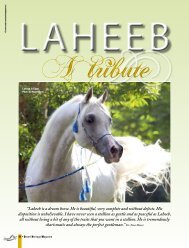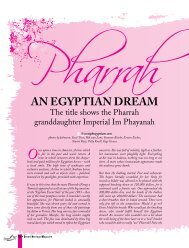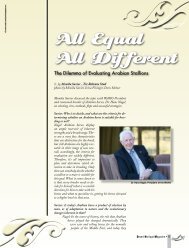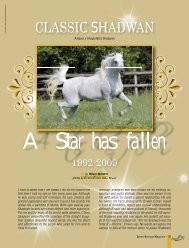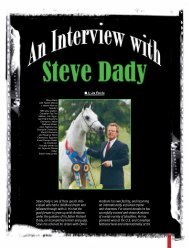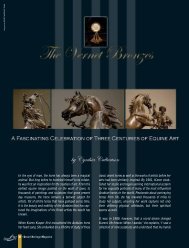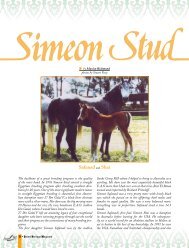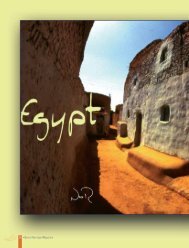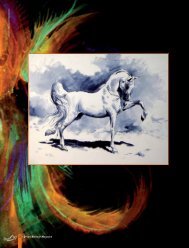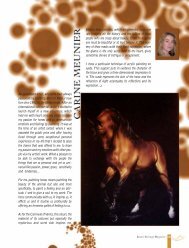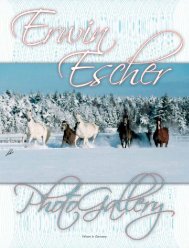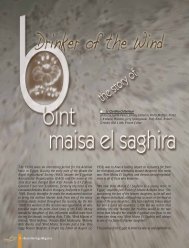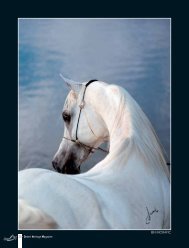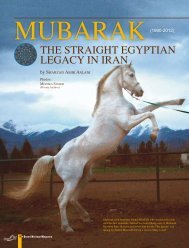Pharrah - Desertheritagemagazine.com desert heritage magazine
Pharrah - Desertheritagemagazine.com desert heritage magazine
Pharrah - Desertheritagemagazine.com desert heritage magazine
You also want an ePaper? Increase the reach of your titles
YUMPU automatically turns print PDFs into web optimized ePapers that Google loves.
) © artwork created by www.<strong>desert</strong><strong>heritage</strong><strong>magazine</strong>.<strong>com</strong> (<br />
136 • Desert Heritage Magazine<br />
Phar<br />
AN EGYPTIAN DREAM<br />
<strong>Pharrah</strong> (Farag x Kamar)<br />
Photo: Johnston<br />
The title shows the <strong>Pharrah</strong><br />
granddaughter Imperial Im Phayanah
ah<br />
Once upon a time in America. A time which is<br />
far in the past and won’t return. A time in which<br />
investors drew the cheque-book and paid millions<br />
for Egyptian horses – with a tired smile. The high<br />
time of syndicates and exclusive auctions. A time<br />
in which Arabian horses were treated and sold as<br />
objects d’art – polished, beamed on by spotlights,<br />
provided with expertises.<br />
It was in this time that the mare <strong>Pharrah</strong> (Farag<br />
x Tamria) appeared as well at one of the big<br />
auctions: at the “Eyptian Event Sale” of the year<br />
1983 – then one of the most pompous events. I<br />
remember exactly her appearance, for <strong>Pharrah</strong><br />
looked so unusually beautiful. She was eleven years<br />
old and seemed to have <strong>com</strong>e directly from one of<br />
these old paintings by Adam or Vernet. Her long<br />
narrow face reminded of her grandsire Morafic,<br />
the long slender supple neck as well. The face was<br />
dominated by those big round dark eyes which<br />
seemd to reflect her Egyptian ancestors. She was<br />
full of nobility, light as a feather, her movements<br />
were playfully light. Everything at her was in<br />
balance, nothing was too long or too short. A mare<br />
whose immaculate appearance made the audience<br />
grow dumb.<br />
<strong>Pharrah</strong><br />
n © straightegyptians.<strong>com</strong><br />
photos by Johnston, Scott Trees, Rik van Lent, Susanne Bösche, Erwin Escher, Stuart Vesty,<br />
Polly Knoll, Gigi Grasso,<br />
But then the bidding started. Fast and vehement. The<br />
buyers literally scrambled for her. Only for seconds a<br />
bidder was allowed to be pleased with the supposed<br />
knocking down at 120,000 dollars, for it continued<br />
with a frantic rate. One approached the 200,000dollar-line,<br />
and the hands of the bidders still went<br />
up. 200,000 dollars! The auctioneer had a short<br />
breather, then he looked around. There were only<br />
few left in the <strong>com</strong>petition. Would it go on? Even I<br />
held the breath. Who would get the knocking down,<br />
who would fulfill himself this Egyptian dream? An<br />
investor who wouldn’t care a bit about the well-being<br />
of the horse later on or a “real” breeder who would be<br />
able to really “use” <strong>Pharrah</strong>? Now the bidding was<br />
at 225,000 dollars, and the auction still went on.<br />
Then there was the knocking down and <strong>Pharrah</strong><br />
changed the owner. “Going, going, gone: 255,000<br />
dollars, sold to Vincent Fortuna!” Applause surged,<br />
the blonde Diane Fortuna flew into her husband’s<br />
arms and everybody was content: <strong>Pharrah</strong>’s seller<br />
Barbara Griffith (Imperial Egyptian Stud) because<br />
the price was right, the Fortunas because they<br />
wanted <strong>Pharrah</strong> – and solely <strong>Pharrah</strong>! – and finally<br />
<strong>Pharrah</strong> herself as an “expectant mother” who seemed<br />
to like everything but the stress of this auction and at<br />
last was alowed to return to her stall!<br />
Desert Heritage Magazine • 137
Some more offspring of Imperial Phanadah:<br />
Imperial Pharouk (by Imperial Al Kamar)<br />
sire of champions in the Middle East<br />
Imperial Pharasha (by Imperial Al Kamar)<br />
successful broodmare at Imperial Egyptian Stud<br />
Imperial Pharaj (by Imperial Imdal<br />
champion stallion in Italy<br />
<strong>Pharrah</strong><br />
138 • Desert Heritage Magazine<br />
Farag<br />
Tamria<br />
Morafic<br />
Bint Kateefa<br />
Tuhotmos<br />
Kamar<br />
Imperial Phanadah<br />
Photo: Scott Trees<br />
Nazeer<br />
Mabrouka<br />
Sid Abouhom<br />
Kateefa<br />
El Sareei<br />
Moniet El Nefous<br />
Nazeer<br />
Komeira<br />
Mansour x Bint Samiha<br />
Sid Abouhom x Moniet<br />
el Nefous<br />
El Deree x Layla<br />
Shahloul x Bint Rissala<br />
Shahloul x Zareefa<br />
Shahloul x Wanisa<br />
Mansour x Bint Samiha<br />
Nabras x Layla<br />
Imperial Im Pharida & Imperial Phanadah in Qatar<br />
Photo: Rik van Lent
Amira Al Shaqab<br />
Photo: Erwin Escher<br />
“Where does this <strong>Pharrah</strong> <strong>com</strong>e from,” some asked themselves<br />
after the auction, and especially: Why was such a beauty sold<br />
at all? Was there perhaps a blemish, a hidden fault one had<br />
missed? Let’s start with <strong>Pharrah</strong>’s origin. She was born on<br />
the 3rd January 1972 at the Hungarian state stud Babolna.<br />
Her sire was the Egyptian import and head stallion for many<br />
years, Farag (Morafic x Bint Kateefa). A dry and very noble<br />
stallion, an image of his famous sire – just without Morafic’s<br />
extreme profile. The dam originates as well from Egypt; it<br />
was the grey mare Tamria (Tuhotmos x Kamar), a sister of<br />
Ibn Morafics dam Kharamana (Anter x Kamar).<br />
As a five-year-old <strong>Pharrah</strong> was sold into the USA and in<br />
1978 she found her home at the Imperial Egyptian Stud.<br />
There she gave birth to five foals in a row. The first was<br />
the best and (up to this day!) the most influential: Imperial<br />
Phanadah (by Ibn Moniet El Nefous). A chestnut who<br />
was defeated by her dam in a direct “beauty contest” but<br />
who turned out to be a real Dam of distinction. Especially<br />
when she was bred to Imperial’s pasha – the in<strong>com</strong>parably<br />
typey and ardent Ansata Imperial (Ansata Ibn Sudan x<br />
Ansata Delilah) – daughters were born who surpassed each<br />
other in expression and beauty. These three mares were the<br />
“glamour ladies” Imperial Phanilah, Imperial Im Pharida<br />
and Imperial Im Phayanah (the mare in the title).<br />
Wheter it be in Qatar, Jordan, Israel, France or in the<br />
United States – everywhere these mares stood in the winners<br />
circle. The most successful of them all was the fleabitten grey<br />
Imperial Phanilah. In Europe she made herself immortal<br />
with winning the World Championships in Paris. After<br />
her victory pass, when the applause surged, she neighed and<br />
pranced: a monument of Arabian beauty a sculptor couldn’t<br />
have figured more ac<strong>com</strong>plished!<br />
Today Imperial Phanilah lives at the “Al Shaqab Stud” of<br />
Qatar’s Crown Prince where she was ac<strong>com</strong>panied for some<br />
time by the late Imperial Im Pharida. Especially Imperial<br />
Phanilah went on to be<strong>com</strong>e a prepotent broodmare; her<br />
first daughter Amira Al Shaqab (by Al Aadeed Al Shab) is a<br />
multiple National Champion Mare of Qatar.<br />
Imperial Im Phayanah, full sister of Imeprial Phanilah<br />
and Imperial Im Pharida, resides at Uri Ariely’s studfarm<br />
in Israel. Her son Shahir (by the German stallion Salaa El<br />
Dine) returned to the USA and served as an outcross stallion<br />
at Arabians Ltd. Today he is owned by Jamal Egyptian<br />
Arabian Stud of Robert Stephenson and is standing at his<br />
farm in Michigan. Shahir is without any doubt one of the<br />
most typey stallions in the US today. One of his sons already<br />
won the Egyptian Event by storm and was named Junior<br />
Champion Colt.<br />
But even at the Imperial Egyptian Stud one doesn’t manage<br />
without any blood of <strong>Pharrah</strong>’s today. Barbara Griffith<br />
esteems the young Imperial Orrapha (Orashan x Imperial<br />
Im Pharida – full sister to Imperial Phanilah) as one of<br />
her best producing mares. Her two-year-old son Imperial<br />
Kamshah (by Imperial Al Kamar) delights every Arabian<br />
horse lover. When he romps over the green hills of Imperial<br />
and his mane and tail flutter in the wind you realise that the<br />
Arabian horse is indeed a “flyer without wings”: He seems to<br />
touch the ground only because of his kindness...<br />
So why did Barbara Griffith separate from <strong>Pharrah</strong> at<br />
that time? “It wasn’t an easy decision,” she admits. “But I<br />
owned three of her daughters who where able to continue<br />
her line.” No “hidden faults” then? “No, absolutely not! Ask<br />
Imperial Phanilah in Qatar<br />
Photo: Susanne Bösche<br />
Desert Heritage Magazine • 139
Imperial Kamshah<br />
Production Record:<br />
140 • Desert Heritage Magazine<br />
Shahir<br />
Photo: Stuart Vesty<br />
Royal Khalifa<br />
Photo: Van Lent<br />
‘76 AK Komeira (by Ibn Galal), chestnut mare - champion producer<br />
‘77 Hal Phalcon (by Ibn Galal-14), grey stallion<br />
‘79 Imperial Phanadah (by Ibn Moniet El Nefous), chestnut mare - champion producer<br />
‘80 Imperial Napharr (by Moniet El Nafis), chestnut stallion<br />
‘81 Imperial Na Pharo (by Moniet El Nafis), grey stallion - champion<br />
‘82 Imperial Pharalima (by Ansata Ibn Halima), grey mare<br />
‘83 Imperial Imphudala (by Ansata Imperial), chestnut mare<br />
‘84 Royal Jalliel (by Ansata Imperial), grey stallion - champion<br />
‘85 Royal Bint <strong>Pharrah</strong> (by Ansata Imperial), chestnut mare - champion producer<br />
‘86 Royal Mikhiel (by Nabiel), grey stallion - champion & sire of champions<br />
‘87 Royal Pharriel (by Nabiel), chestnut mare<br />
‘89 Royal Farrah (by El Halimaar), grey filly - deceased as a yearling<br />
Royal Jalliel<br />
Photo: Polly Knoll
Diane and Vincent Fortuna wheter they have ever regretted<br />
the buying!” A question which is superflous. Even today –<br />
eight years after <strong>Pharrah</strong>’s death – there is no other horse<br />
for Diane. “To me <strong>Pharrah</strong> was the ideal of an Egyptian<br />
mare – beautiful and gentle, noble and sublime and the best<br />
broodmare you could find!”<br />
Two <strong>Pharrah</strong> sons were born at Fortuna’s stud. The first<br />
was Royal Jalliel, an Ansata Imperial son born in 1984.<br />
A gentle stallion whose character was obviously dominated<br />
by the calmness af his dam. From birth on he was a real<br />
“beau” – perfectly balanced, perfectly graceful. Comletely his<br />
mother’s son. His head was shorter than Paharrah’s, there his<br />
sire came through.<br />
The half brother Royal Mikhiel (by Nabiel) , two years<br />
younger, resembled more his sire as well. Full of power,<br />
stronger and more masculine than his brother, more ardent<br />
and more spirited than him. Although both stallions were<br />
successful in the show ring, Royal Mikhiel surpassed his<br />
older brother with his self-confident appearance and his<br />
longer lines.<br />
At the Egyptian Event in 1991 “Mike” celebrated his<br />
greatest triumph: He was the Reserve Supreme Champion<br />
Stallion! His name by the way isn’t Arabic, although it<br />
might sound like that for our ears. Diane Fortuna explains,<br />
“Mikhiel is a <strong>com</strong>bination of the name of my son Michael<br />
– because he was born on the same day – and of Nabiel, the<br />
name of Mikhiel’s famous sire!”<br />
Until a few years ago both stallions were standing in Canada<br />
(at Montebello) and covered every year a considerable number<br />
of mares. After the decline of this farm Royal Jalliel was sold<br />
to Marylin Hay in Minnesota. As always, the younger one<br />
made a bigger stir: he was exported to Jordan by the Royal<br />
Jafaar Stud. There he can prove his qualitis as a sire. This at<br />
least the older brother has done already: some of his sons and<br />
daughters were able to win in the show ring. The delicate<br />
mare Imperial Jaliisa (Royal Jalliel x Glorieta Maarqesa)<br />
for example was the 1993 Reserve Junior Champion Filly<br />
of Qatar’s National Show. And in the same year she won the<br />
junior title at the “Middle East Championships”.<br />
In 1990, there was a heavy blow for destiny sent a cruel<br />
conflagration. The farm of the Fortunas and some of their<br />
horses fell victims of the flames. The stud is located in Santa<br />
Barbara, very idyllically in a valley amidst woods. This<br />
valley became a fatal trap for sixteen horses. Diane and<br />
Vincent Fortuna saw the fire approaching their farm and<br />
tried to place as many horses as possible on the only truck<br />
and to save themselves and a part of the horses. It was a race<br />
against time. Literally in the last second they escaped from<br />
Royal Mikhiel<br />
Photo: Gigi Grasso<br />
the fire storm which destroyed large parts of Santa Barbara.<br />
Left behind – with fifteen other horses – was <strong>Pharrah</strong>’s<br />
youngest and last daughter Royal Farrah (by El Halimaar).<br />
What could have be<strong>com</strong>e of her...<br />
Today the Fortunas breed only with the chestnut <strong>Pharrah</strong><br />
daughter Royal Pharriel (by Nabiel), her daughters and one<br />
son, the grey Royal Phariel (Royal Jalliel x Royal Pharriel).<br />
He resembles <strong>Pharrah</strong> very much and one should keep him<br />
in mind. He certainly still needs time to mature but then one<br />
should have a look at him again!<br />
The mare Royal Bint <strong>Pharrah</strong> (by Ansata Imperial) was<br />
sold to Washington by the Fortunas two years ago. She<br />
as well is represented in the Arabian area by outstanding<br />
offspring. Her daughter Royal Kahlifa (by El Halimaar) is<br />
one of the favourites of Sheikh Nawaf Bin-Nasser Al Thani<br />
of Qatar. Her spirited son Harp (by Imperial Madheen) –<br />
Arabic for war – was the National Junior Champion Colt<br />
there in 1993.<br />
<strong>Pharrah</strong> died in 1991. Her beauty could and can hardly<br />
be described. She was like a dream, the vision of timeless<br />
elegance. Maybe one must have experienced her, touch her<br />
soft muzzle, heard her snort, seen her look out of expressive<br />
eyes. Only then you knew that sometimes dreams do <strong>com</strong>e<br />
true... q<br />
Desert Heritage Magazine • 141



